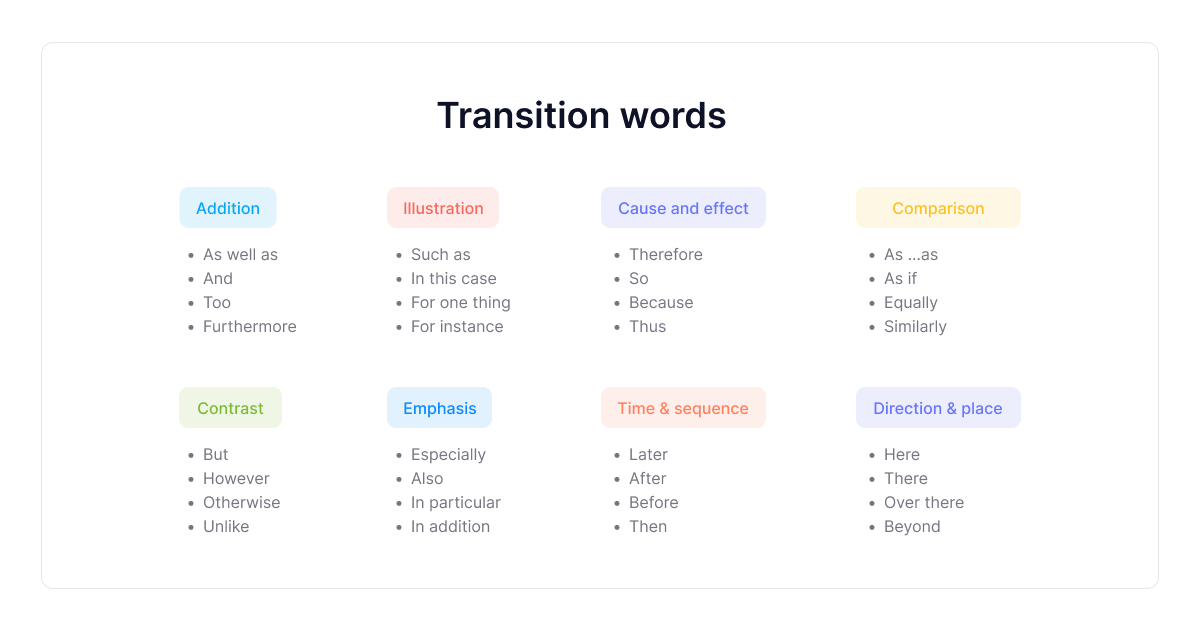As a writer, you know that there is nothing that puts off readers more than a monotonous narrative.
Therefore, an essential element of writing is varying your syntax and written rhythms to maintain your reader's attention and keep them engaged.
This variation can include word choice, tone changes, vocabulary choice, and sentence structure.
If you struggle with making your writing more varied and vibrant, you’re in the right place.
We’re going to show you how to change a sentence structure in 6 ways.
Thus, by the end of this article, you will have a better understanding of how to change a sentence structure and use various methods for different purposes.
Ready to get started?
Let’s dive in!
What is a Sentence Structure?
Let’s start with the basics first and define a sentence structure. A sentence structure represents the way a writer forms a sentence.
Therefore, a high-quality piece of writing needs to include variations in
sentence length, style, and type of sentences.
All these factors will contribute to reducing monotonous and vague text.
6 Ways to Change Sentence Structure
1. Vary Sentence Opening
What visuals are for posts, that’s what sentence openings are for text. Varying words or pronouns that open a sentence will make your writing more lively and dynamic.
For example, if you tend to overuse one and the same pronoun like in the example above, it doesn’t make your writing very dynamic.
However, take a look at the variation. Isn’t it more vibrant? Instead of constantly starting with the same pronoun, use a prepositional phrase or dependent clauses.
Speaking of prepositions, they usually come at the end of the sentences to make them more neutral or less emphasized.
But if you want to “shake” a sentence structure and emphasize the sentence, try placing the prepositions at the beginning of a sentence.
This wouldn’t change the meaning, only the emphasis.
Compare these two sentences:
- She was sitting all alone in a dark corner.
- In a dark corner, she was sitting all alone.
Although same in meaning, these sentences have different impacts. The second one is more dramatic, almost creating an element of suspense.
2. Vary Sentence Length
Varying sentence length goes hand in hand with the types of sentences: simple, compound, or complex.
Don't worry, you don’t need to be a language expert and know the difference between them.
As a general rule of thumb, combine sentences of various lengths and structures to make them less plain.
Having consecutive long sentences can inundate a reader and cause them to lose focus or, even worse, interest.
In addition, having consecutive short sentences makes your text easier to read, but it also makes it harder to realize the focal point of your text.
Therefore, the optimal solution would be to combine longer and shorter sentences and use the best of both worlds: shorter sentences to emphasize important parts while providing more info with longer ones.

As mentioned earlier, sentence length is intertwined with sentence types.
Combining simple, compound and complex sentences affect the length and the principle is the same.
Don’t overuse just one type of sentence. Mix them and create more energetic impact on your readers.
3. Use Linking Expressions
There is a big chance you are using linking expressions without even realising it. So , what are linking expressions? You might know them as transition words.
Technically, these are conjunctions or adverbs that you use to start your sentences.
Depending on their purpose they are divided into the following categories:
- To express agreement or reinforce the meaning: In additon, Moreover, Furthermore, What’s more, Additionally, etc.
- To express contrast or disagreement: Although, Despite, In spite of, Conversely, On the other hand, Regardless, Nonetheless, On the contrary, etc.
- To express cause or purpose: Provided that, Given that, In case of, Due to, Because, In order to, While, With this in mind, In the event that, etc.
- To express examples or emphasis: For example, For instance, By all means, Indeed, Surely, In fact, In general, Especially, Particularly, etc.
- To express a consequence or a result: Thus, Hence, As a result, Accordingly, Therefore, Consequently, In that case, In effect, etc.
- To express conclusion: To sum up, On the whole, On balance, All things considered, As shown above, Generally speaking, In the long run, etc.
- To express time sequence: Meanwhile, During, In due time, Next, First, Since, Once, As soon as, Suddenly, etc.

Using transition or linking words is one of the most effective ways to vary your writing and to successfully combine and link shorter sentences together.
4. Use Active Voice
Using active voice is more favourable than using passive voice.
A funny side note is that English uses passive voice more compared to some other European languages. In addition, it actually uses passive voice primarily in writing.
So how come we’re suggesting not using it?
Well, a lot will depend on a type of writing.
Passive is pretty much a must in academic papers and essays, but for example, in blogs or more informal writings, it is almost obsolete.
Therefore, just pay attention to what type of content you’re producing.
When it comes to blog writing, active voice is a better option, because it is, as the name suggests, more active and therefore dynamic.
Not only that, but active emphasizes a doer of some action rather than an object, which feels more natural.
5. Use Modifiers
Modifiers are also one of the more powerful assets when it comes to changing sentence structure. They give extra information about a part of the sentence or a word.
What’s more, you can also use them to emphasize or intesify a piece of information.
Modifiers are usually adjectives or adverbs, but they can also be clauses.
Perhaps the most famous pair of modifiers are really and very. Some other examples include:
- Quite
- Rather
- Fairly
- Absolutely
- Totally
- Extremely,
- And many more.
However, there are a few things to pay attention to when using modifiers. You shouldn’t overuse them or place too many of them in one sentence.
In addition, place them in such a position that it is obvious what they modify. This will prevent any ambiguity that might occur.
For example:
Gazing at the distant island, the waves touched Jane’s feet. What seems to be off here?
The first part Gazing at the distant island modifies Jane, but the way it was placed in the sentences suggests that it modifies the waves.
And that, of course isn’t possible-waves can do many things, but gazing isn’t one of them.
Therefore, correct placement of a modifier in this instance would be:
Gazing at the distant island, Jane felt the waves touching her feet.
No ambiguity whatsoever now.
6. Use Rhetorical Questions
Do you like our article so far?
This is an example of a rhetorical question.
These types of questions are there to engage readers more and stimulate their interest by making them think about the question.
Rhetorical questions, therefore, speak to readers. By using rhetorical questions, you are trying to make some point and not actually get an answer to the question.

We’ve shown you how to change a sentence structure in 6 ways, but as a special bonus, we’re going to show you how you can change a sentence structure with Text Cortex.
How to Change a Sentence Structure With TextCortex?
Having a varied sentence structure is the key to creating compelling, lively and engaging pieces of text.
The good thing is that there are AI-powered writing tools that can help you in this process.
Not only can they help you with sentence structure but they also provide suggestions and recommendations for other aspects of writing.
What is TextCortex?
TextCortex is a text processing and paraphrasing tool helping you get the most out of your content easily and more efficiently.
TextCortex hosts many features, and some of them are:
- A user-friendly interface.
- Advanced writing tools to write and rewrite your text.
- More than 60 AI templates for various industries
- Access to more than 30 popular online platforms and text editors such as Facebook, Gmail, Google Docs, etc.
How to Change a Sentence Structure in Your Writing With TextCortex?
Once you’ve downloaded a free Chrome extension, you just need to type or write a text you want to edit.
After that, you just highlight the text and choose whether you’d like to:
- rephrase the text,
- expand it,
- summarize it
- change the tone
- autocomplete the text or
- translate it
And then, just click on the designated icon. You will get a few variants, so you can copy or save the one you like most.
You can also tweak it further and apply other tools and features such as transforming bullet points to emails and generating paragraphs by highlighting the title.
There is more than meets the eye, but our focus today is on the features useful for changing sentence structure.
Sounds promising?
Download a Chrome Extension to create dynamic and engaging content. You’ll love it and your readers will love it, too.
.jpg)
![6 Ways To Change A Sentence Structure [Step-by-step Guide]](https://textcortex.com/cdn-cgi/image/format=avif,quality=90/https://assets-global.website-files.com/622611a2b23d0e6b270fba81/6393e7bc15410212df3b4768_how-to-change-sentence-structure.png)



